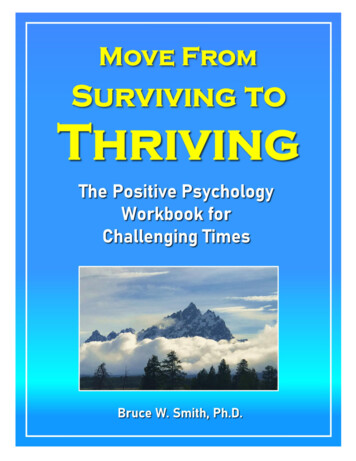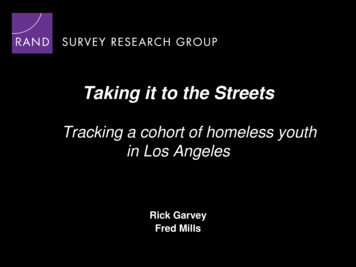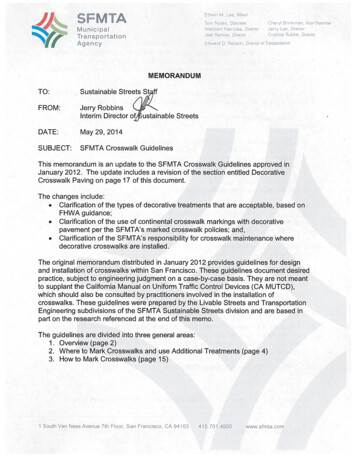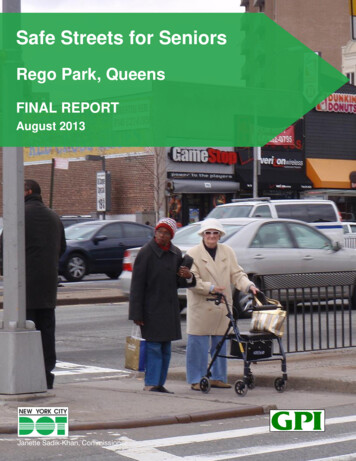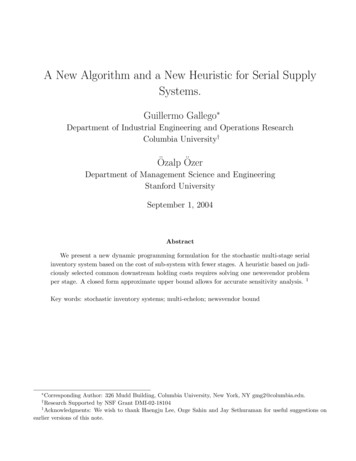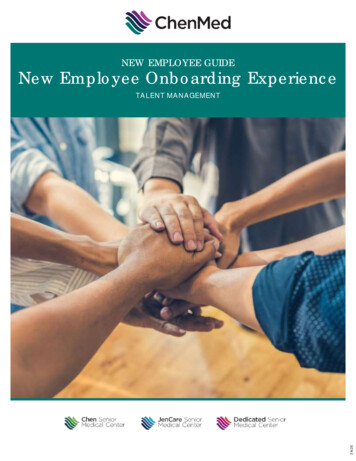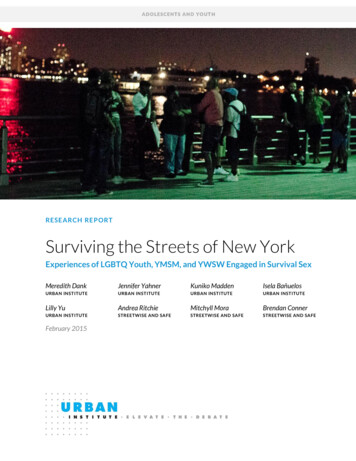
Transcription
ADOLESCENTS AND YOUT HRESEARCH REPORTSurviving the Streets of New YorkExperiences of LGBTQ Youth, YMSM, and YWSW Engaged in Survival SexMeredith DankJennifer YahnerKuniko MaddenIsela BañuelosURBAN INSTITUTEURBAN INSTITUTEURBAN INSTITUTEURBAN INSTITUTELilly YuAndrea RitchieMitchyll MoraBrendan ConnerURBAN INSTITUTESTREETWISE AND SAFESTREETWISE AND SAFESTREETWISE AND SAFEFebruary 2015
ABOUT THE URBAN INSTITUTEThe nonprofit Urban Institute is dedicated to elevating the debate on social and economic policy. For nearly fivedecades, Urban scholars have conducted research and offered evidence-based solutions that improve lives andstrengthen communities across a rapidly urbanizing world. Their objective research helps expand opportunities forall, reduce hardship among the most vulnerable, and strengthen the effectiveness of the public sector.Copyright February 2015. Urban Institute. Permission is granted for reproduction of this file, with attribution tothe Urban Institute. Cover image from Will Anderson.
ContentsAcknowledgmentsvHighlights1Terminology and Definitional Considerations3Youths’ Engagement in the Commercial Sex Trade for Survival5Current Study Goals and Methodology9Findings12What Are the Characteristics of LGBTQ Youth, YMSM, and YWSW Engaged in Survival Sex in NewYork City?12Gender12Sexual Orientation13Race15Age and Children15Education15Birthplace15Living Situation16Money Debt17What Are LGBTQ Youths', YMSM’s, and YWSW’s Pathways into the Survival-Sex Trade?17Age of Entry18Reasons for Involvement19Experiences of Young Men Who Have Sex with Men (YMSM) and Young Women Who Have Sexwith Women (YWSW)What Are the Characteristics of the Commercial Sex Market?2223Frequency of Trading23Getting Customers23Number of Clients and Regulars27Customer Demographics29Locations31Profiling by Police32What Do Youth Earn, and How Do They Spend Earnings?33Payments and Exchanges33How Youth Spend Their Earnings35Sharing Earnings with Others36What Are the Physical Risks, and How Do Youth Protect Themselves?Arguments and Fights3939
Physical Protection41How Do Others Help Youth Find Customers?44How Many Youth Are Involved in Exploitative Situations?46How Youth Met Exploiters48Nature of Exploitative Situations and Relationships with Exploiters49Others Working for Exploiters51Leaving Their Exploiters53What Do Youths’ Networks Look Like?54What Are Youths’ Perceptions of Engaging in Survival Sex?56Positive Perceptions of Engaging in Survival Sex56Negative Perceptions of Engaging in Survival Sex57Does Engaging in Survival Sex Define Who Youth Are?60Desire to Stop Engaging in Survival Sex61Concluding Personal Statements65Discussion and Summary67Policy and Practice Recommendations70Main Findings79Notes81References83About the Authors86Statement of Independence88
AcknowledgmentsThis project was funded by award 2011-JF-FX-0001, awarded by the Office of Juvenile Justice andDelinquency Prevention, Office of Justice Programs, US Department of Justice. We are grateful to ourfunders, who make it possible for Urban to advance its mission. It is important to note that funders donot determine our research findings or the insights and recommendations of our experts.The authors would like to thank (1) the brave and resilient youth who participated in this study; (2)the staff of Streetwise and Safe who assisted us in identifying appropriate youth and conductinginterviews for this study, especially Kimi Lundie, Jonathan Gonzalez, and Bhavana Nancherla; and (3)the Urban Institute full-time and temporary staff who assisted throughout various stages of datacollection, transcription, and coding: Pam Lachman, Dwight Pope, Doug Gilchrist-Scott, AndreaMatthews, Emily Tiry, and Rachel Goldberg.We would also like to thank those who provided a careful review of project findings:representatives of the Office of Juvenile Justice and Delinquency Prevention, especially Barbara TatemKelley and Karen Bachar, Dr. Janine Zweig of the Urban Institute’s Justice Policy Center, Rhodes Perry,and Deanna Croce. In addition, we are grateful for the editorial support of Ashleigh Andrews Rich andFiona Blackshaw at the Urban Institute, as well as the ongoing support of Nancy La Vigne and KateVillarreal of Urban’s Justice Policy Center.ACKNOWLEDGMENTSV
HighlightsIn 2011, researchers from the Urban Institute launched a three-year study of lesbian, gay, bisexual,transgender, and queer or questioning (LGBTQ) youth; young men who have sex with men (YMSM); andyoung women who have sex with women (YWSW) engaged in survival sex in New York City. Working inpartnership with the New York City–based organization Streetwise and Safe (SAS), researchers trainedyouth leaders to conduct in-depth interviews with a total of 283 youths who engaged in survival sex inNew York City and identified themselves as LGBTQ, YMSM, or YWSW. During these interviews, youthwere asked a wide range of questions about their backgrounds and experiences. The information theyshared paints a vivid picture of how they survive in the face of adversity, often dealing with issuesrooted in poverty, homophobia, transphobia, racism, child abuse, and criminalization. Using amultimethod analytic approach, we identified a number of key findings, highlighted below anddescribed further throughout this report: Youth reported experiences of social and familial discrimination and rejection, familialdysfunction, familial poverty, physical abuse, sexual abuse and exploitation, and emotional andmental trauma. The experiences of youth engaged in survival sex are not static; they change over the course ofyouths’ involvement in exchanging sex for money and/or material goods. For example, youngpeople might be recruited by an exploiter but then eventually trade independently to meettheir basic needs, or vice versa. LGBTQ youth tend to have large peer networks, which include youth who engage in survivalsex. Many young people are introduced to the survival-sex economy through such networks. LGBTQ youth, YMSM, and YWSW lack access to voluntary and low-threshold services,including short- and long-term housing, affordable housing and shelter options, livable-wageemployment opportunities, food security, and gender-affirming health care. Many of the youthwho are able to access these services experience institutional barriers. Among the few serviceproviders and public benefits programs that exist, LGBTQ youth, YMSM, and YWSW reporthigh rates of service denial, as well as violence from breach of confidentiality and unsafe anddiscriminatory treatment by staff and other recipients of these services, on the basis of theirsexual orientation, gender identity, gender expression, and age.HIGHLIGHTS1
Many youth engaged in survival sex experience frequent arrest for various “quality-of-life” andmisdemeanor crimes, creating further instability and perpetuating the need to engage insurvival sex. In custody, many youth experience violence on the basis of their perceived sexualorientation and gender identity. Youth experience violence and abuse from multiple sources, including families, exploiters,clients, strangers, peers, and law enforcement. Youth also experience violence at the hands ofstaff and clients at social service organizations and other locations that are intended to be safe. Many youth report disappointing or frustrating experiences with social service systems andproviders, which often fail to meet their need for safe housing, reliable income, and adequatemental and physical health care, as well as for freedom, independence, and self-expression. Youth are extremely resilient in the face of external challenges (such as violence and lack ofhousing and employment) and internal challenges (such as emotional and physical trauma andgender and sexual identity issues). They find ways to survive, often relying on their informalnetworks, street savvy, and quick learning abilities to share resources and skills and to adapt todifficult and often dangerous situations.This study is among the first to focus on the experiences of LGBTQ youth, YMSM, and YWSW whohave self-reported engagement in survival sex in New York City. Despite a recent increase in studiesconcerning the commercial sexual exploitation of children and survival sex, there has been a paucity ofresearch focused on the experiences of YMSM, YWSW, and LGBTQ youth engaged in survival sex(Dennis 2008). Some of the existing literature assumes that young men and transgender youth whoengage in survival sex do so voluntarily or as a by-product of a “deviant homosexual” subculture; othersargue that unlike female youth, male youth take only pleasure from engagement in the sex trade orapproach such engagement as a coming-of-age rite (Dennis 2008). However, few existing studies ofyouth engaged in survival sex use peer-to-peer interviews to explore LGBTQ youths’ perspectives ontheir own experiences, circumstances, service needs, and desires for individual and social change(McIntyre 2005, 2006, 2008a, 2008b; YWEP 2009, 2012). A main goal of this study is to describe andquantify these youths’ experiences and characteristics to gain a better understanding of theirengagement in survival sex and how the support networks and systems in their lives have both helpedthem and let them down.HIGHLIGHTS2
Terminology and Definitional ConsiderationsBefore we discuss the study’s findings, it is important to address and define the terms we choose to usethroughout this report. Some of the terms we use reflect the word choices of the young people weinterviewed. These terms describe the youths’ behaviors and experiences, as opposed to labeling thembased on these behaviors and experiences.Cisgender: Individuals whose experiences of their gender match the sex they were assigned at birth.Gender expression: The aspects of behavior and outward presentation that may (intentionally orunintentionally) communicate gender to others in a given culture or society. These aspects includeclothing, body language, speech, hairstyles, socialization, interests, and presence in gendered spaces(e.g., restrooms, places of worship, etc.), among others. A person’s gender expression may vary from thegender norms traditionally associated with the person’s sex assigned at birth. Gender expression isseparate from gender identity and sexual orientation (Perry and Green 2014).Gender nonconforming: People who have or are perceived to have gender characteristics orbehaviors that do not conform to traditional or societal expectations. Gender nonconforming peoplemay or may not identify as transgender. While gender nonconforming people are often assumed to belesbian, gay, or bisexual, sexual orientation cannot be determined by a person’s appearance or degree ofgender conformity (Perry and Green 2014).Sexual orientation: Whom a person is physically and emotionally attracted to. Sexual orientation isdistinct from gender identity; transgender people may identify as heterosexual, bisexual, gay, lesbian, orany other sexual orientation.Transgender: People whose gender identity (internal sense of being female, male, or anothergender) is incongruent with their sex assigned at birth (physical body). Transgender is also used as anumbrella term to refer to communities of people that include all whose gender identity or genderexpression do not match society’s expectations of how they should behave in relation to their gender(e.g., transsexual, transgender, genderqueer, gender nonconforming, and other people whose genderexpressions vary from traditional gender norms) (Perry and Green 2014).Young men who have sex with men (YMSM): Young men who may identify as heterosexual but havesex with members of the same sex, often in exchange for money and/or material goods.Young women who have sex with women (YWSW): Young women who may identify as heterosexualbut have sex with members of the same sex, often in exchange for money and/or material goods.HIGHLIGHTS3
Exploiter: An individual who uses tactics involving force, fraud, and coercion to control a young person’sinvolvement in the commercial sex market.Peer facilitator: A peer, who may or may not be engaged in survival sex, who providesnonexploitative support to someone engaging in survival sex, such that the person engaging in survivalsex does not have limited mobility; decides what they do and what they trade sex for; and is not subjectto force, fraud, or coercion.Youth engaged in survival sex: The terms “youth engaged in survival sex” and “youth who exchangesex for money and/or material goods (e.g., shelter, food, and drugs)” are used here to reflect youngpeople’s experiences of involvement in the commercial sex market in their own terms. These termsdescribe a behavior as opposed to labeling the youth themselves.HIGHLIGHTS4
Youths’ Engagement in theCommercial Sex Trade for SurvivalPopulation estimates of youth who trade sex for survival vary considerably. Curtis and colleagues1(2008), using respondent-driven sampling methods, estimated that as many as 4,000 individuals underage 21 were engaged in New York City’s commercial sex market. A much lower estimate by Gragg andcolleagues (2007), generated with interview and service data from law enforcement and youth serviceproviders in New York City, indicated a population of approximately 2,250 youth who exchanged sexfor money and material goods.Regardless of the exact number, the limited literature on LGBTQ youth engagement in survival sexreveals that such youth are likely to share several common experiences before exchanging sex formoney and/or material goods. These experiences may include racism; family poverty; homelessness andits associated stigma; lack of adequate or safe housing options; lack of access to gender-affirmingmedical care; and rejection and discrimination based on sexual orientation or gender identity byfamilies, communities, and employers (Bigelsen and Vuotto 2013; Gwadz et al. 2009; Lankenau et al.2005; NYCAHSIYO 2012; Rees 2010; Wilson et al. 2009). Additionally, LGBTQ youth experiencehomophobic and transphobic harassment, discrimination, and physical violence within the child welfareand foster care systems and emergency and short- and long-term shelters, and from health careproviders, social services, law enforcement, and other government institutions (NYCAHSIYO 2012; Ray2006; YWEP 2012).Homelessness is one of the most common drivers of youth engagement in survival sex (Institute ofMedicine and National Research Council 2013; Weber et al. 2004). Nationally, estimates of theproportion of runaway and homeless youth involved in survival sex range from 10 percent to as high as50 percent (Greene, Ennett, and Ringwalt 1999; Halcón and Lifson 2004; Haley et al. 2004; Tyler 2009;Weber et al. 2004). Studies focused on New York City consistently report that homeless youth oftentrade sex for a place to stay each night because of the absence of available shelter beds (Freeman andHamilton 2008), and that approximately a quarter of homeless youth in New York City have traded sexat some point (Bigelsen and Vuotto 2013; Clatts et al. 1998; Rotheram-Borus et al. 1992).These figures are even more striking for LGBTQ youth, YMSM, and YWSW in New York City.According to a survey of nearly 1,000 homeless youth in New York City, young men were three timesmore likely than young women to have traded sex for a place to stay, and LGBTQ youth were sevenYOUTHS’ ENGAGEMENT I N THE COMMERICAL SEX TRADE FOR SURVIVAL5
times more likely than heterosexual youth to have done so (Freeman and Hamilton 2008). Transgenderyouth in New York City have been found eight times more likely than nontransgender youth to tradesex for a safe place to stay (Freeman and Hamilton 2008). Nationally, 48 percent of transgender peoplereporting involvement in sex work also report homelessness (Grant et al. 2011).The number of homeless youth who report trading sex for shelter corresponds to the number ofyouth involved in the sex trade who report having experienced homelessness. The vast majority ofyoung men and transgender youth interviewed by Curtis and colleagues (2008) reported beinghomeless, including a significant proportion of young men who reported engaging in survival sex whileliving on the streets. An earlier ethnographic study of YMSM who traded sex for money or materialgoods in New York City found that 9 out of 10 interviewed youth were homeless at the time they begantrading sex (Lankenau et al. 2005). Further, another study found that over half of transgender youthinterviewed in Chicago and Los Angeles who had traded sex had spent one or more nights in a shelter,had a precarious housing situation, or were living on the street (Wilson et al. 2009).Homelessness is thus a driver for involvement in survival sex and an ongoing issue for a significantproportion of youth who trade sex for money and/or material goods, especially LGBTQ youth whoexperience exclusion, discrimination, and abuse within their families, schools, shelters, and socialservices (Bigelsen and Vuotto 2013; Curtis et al. 2008; Gaetz 2004; Gwadz et al. 2009; Maitra 2002;McIntyre 2005, 2006, 2008a, 2008b; NYCAHSIYO 2012; Thukral and Ditmore 2003; Thukral, Ditmore,and Murphy 2005; Tyler 2009; YWEP 2009, 2012).According to the Center for American Progress and the National Gay and Lesbian Task Force, adisproportionate number of homeless youth identify as lesbian, gay, bisexual, transgender, or queer(Quintana, Rosenthal, and Krehely 2010; Ray 2006). Further, youth service providers report that2LGBTQ youth prefer to engage in survival sex or “couch surfing” that involves sexual exchange, ratherthan risk experiencing the abuse and potential violence they sometimes face in youth shelters or fostercare (NYCAHSIYO 2012). Transgender youth in particular report a lack of access to transition-relatedtreatment centers and to safe shelter in sex-segregated facilities (Rees 2010). Transgender youth inNew York City have been found eight times more likely than nontransgender youth to trade sex for asafe place to stay (Freeman and Hamilton 2008). Nationally, 48 percent of transgender peoplereporting involvement in the commercial sex market also report homelessness (Grant et al. 2011).While each individual’s life circumstances differ and many factors contribute to engagement insurvival sex, the explanations given by LGBTQ youth often highlight survival and economic need.LGBTQ youth who exchange sex for money and/or material goods in New York City report endemicYOUTHS’ ENGAGEMENT I N THE COMMERICAL SEX TRADE FOR SURVIVAL6
race- and gender-based job discrimination and limited to nonexistent economic choices resulting fromdiscrimination from families, police, and social services (Gwadz et al. 2009; Maitra 2002; Rees 2010). Anational survey of transgender people found that 61 percent of those engaged in sex work hadexperienced employment discrimination (Grant et al. 2011).While transgender youth report active efforts to find alternative sources of income, few manage toget even an initial interview, and many report direct discrimination on the basis of gender identity andexpression (Rees 2010). Similarly, more than two-thirds of transgender youth who had engaged insurvival sex in Chicago and Los Angeles reported experiencing problems getting a job because of theirgender identity or presentation, and consequently earning less than 12,000 a year (Wilson et al. 2009).Transgender youth whose gender expression was perceived as gender nonconforming reportedabsolutely no employment options (Rees 2010). Many transgender youth saw trading sex as a moreethical option than others available to them; as one youth said, “It’s better to try and make money on thestreet than to have to steal off people; at least I’m doing this for myself” (Rees 2010).Prior engagement with child welfare and juvenile justice systems is also a predominant theme in theliterature (Freeman and Hamilton 2008; Lankenau et al. 2005; Wilson et al. 2009). Gragg and colleagues(2007) found that the overwhelming majority of youth engaged in survival sex had prior child welfareinvolvement, typically in the form of child abuse and neglect allegations or investigations (69 percent)or foster care placements (75 percent). Further, over half had a prior juvenile justice placement, and 45percent had a prior persons-in-need-of-supervision placement.Childhood sexual abuse experiences have also been hypothesized to be among the factorscontributing to youth involvement in the sex trade (Estes and Weiner 2001). One study of New YorkCity homeless youth found that “78% of those who engaged in commercial sexual activity reportedhistories of childhood rape or molestation” (Bigelsen and Vuotto 2013, 5). However, other researchershave found that controlling for other variables has eliminated any statistically significant correlationbetween sexual abuse and engagement in survival sex (Tyler 2009).The relationship between childhood sexual abuse and involvement in the sex trade has been foundto be indirect. A 2001 study found that childhood sexual abuse was more closely correlated withrunning away from home at a young age to escape the abuse, which was, in turn, positively correlatedwith trading sex to meet survival needs (Tyler et al. 2001). Weber and colleagues (2004, 592) came tosimilar conclusions in research they describe as “the only prospective analysis of antecedents toprostitution among female street youths.” Other factors the research has linked to youth who exchangesex for money and/or material goods include alcohol use, drug use, and pregnancy history (Edwards,YOUTHS’ ENGAGEMENT I N THE COMMERICAL SEX TRADE FOR SURVIVAL7
Iritani, and Hallfors 2006; Estes and Weiner 2001; Halcón and Lifson 2004; Walls and Bell 2011;Weber et al. 2004).Economic difficulties related to housing and the lack of available employment and health careoptions are among the predominant factors driving LGBTQ youths’ engagement in survival sex. Giventhis backdrop of extreme hardship, this study aims to document the characteristics, experiences, andbackgrounds of LGBTQ youth, YMSM, and YWSW who exchange sex for money and/or materialgoods—using their own words.YOUTHS’ ENGAGEMENT I N THE COMMERICAL SEX TRADE FOR SURVIVAL8
Current Study Goals andMethodologyWith funding from the Office of Juvenile Justice and Delinquency Prevention, Urban Instituteresearchers set out to accomplish two primary goals: (1) to describe and quantify the characteristicsand needs of the LGBTQ youth, YMSM, and YWSW populations engaged in survival sex in the New YorkCity commercial sex market; and (2) to assess their interactions with governmental and nonprofitservice providers, law enforcement, prosecutors, and court personnel. This study is based on thepremise that in-depth, peer-to-peer interviews are needed to fully explore and understand theexperiences of LGBTQ youth, YMSM, and YWSW who exchange sex for money and/or material goods.We use a multimethod (quantitative and qualitative) approach to address the study’s goals.3The Urban Institute project team partnered with Streetwise and Safe’s (SAS) program to conductin-depth interviews with approximately 300 youths recruited using a respondent-driven sampling4(RDS) strategy. Urban researchers trained SAS youth leaders to identify RDS seeds and conductinterviews with LBGTQ youth, YMSM, and YWSW. Seven youth leaders were trained over the course ofthe data collection period, which lasted approximately one year, though one youth leader conducted alarge number of the interviews.Respondent-driven sampling was used to recruit and survey successive waves of youth throughtheir social networks. We set out to recruit approximately 300 LGBTQ youth, YMSM, and YWSWinvolved in the commercial sex market, and ultimately recruited and interviewed 283 young people.One of the strengths of the RDS strategy is that it employs study participants as recruiters of additionalparticipants in consecutive waves of survey interviewing. A small number of research subjects ( n 13),considered the first wave of recruits or initial seeds, was carefully selected with the help of local serviceproviders and SAS youth leaders.In targeting LGBTQ youth, YMSM, and YWSW involved in the commercial sex market, we setspecific eligibility criteria for inclusion in the sample. These eligibility criteria included an age of 13–215years old; identification as LGBTQ, YMSM, or YWSW; and involvement in the commercial sex marketin New York City (i.e., receives cash or in-kind payment in exchange for sex, and trades in the New YorkCity area). To ensure that sample and social network attributes reached equilibrium, four or morewaves of chain-referral sampling were achieved (Heckathorn 1997, 2002; Wang et al. 2005). Further, toreduce any bias in the initial seeds, we sought out demographically varied participants with a largeCURRENT STUDY GOALS AND METHODOLOGY9
number of relationships with youth involved in the commercial sex market, in addition to the motivationand ability to recruit participants like themselves. Using these RDS methods, we were able to interviewa demographically diverse and representative sample of the LGBTQ youth, YMSM, and YWSWpopulation involved in the commercial sex economy in New York City.The initial seed participants were given paper business card–sized coupons with a toll-free 24-hournumber that youths could call to arrange an interview appointment. Both Urban and SAS staffmonitored incoming phone calls to screen prospective research subjects for study eligibility; those whoappeared eligible were given an interview time and the address of the SAS office where the majority of6the interviews were conducted. Upon arrival, subjects were rescreened for eligibility, appropriatenessfor recruitment into the study (e.g., youth who exhibited signs of severe mental health or cognitivedisabilities were not interviewed), and any other referrals or interventions that might be required.7Those who did not identify as LGBTQ, YMSM, or YWSW; were too old; or were not engaged in thecommercial sex economy were deemed ineligible for the interview but were given referrals to youthoriented service agencies and made aware of the services those organizations provided. Those whowere deemed ineligible for other reasons, including perceived negative impact on mental health or wellbeing, were not interviewed. Researchers documented all efforts to provide appropriate referrals orassistance in special incident reports.Youth who were rescreened and deemed eligible and appropriate for the study were subsequently8recruited and interviewed after the researchers obtained their informed assent. At the end of the firstinterview, each respondent received 20 in cash, in addition to three unique, coded coupons that theywere instructed (through a brief education session) to pass to other YMSM, YWSW, or LGBTQ youthwho were part of the commercial sex market. Youth participants were paid an additional 10 persuccessful referral. Unique numeric codes on the front of each coupon allowed the researchers toprevent duplication, to identify which youth recruited subsequent participants, and to keep track ofoverall recruitment patterns. These methods also ensured research transparency for study participantsand helped maintain participant confidentiality while taking advantage of peer network referrals. Theparticipants referred by the initial seeds made up the first wave of the sample and were given threecoupons to pass along to potential new recruits. After this, the process was self-sustaining and resultedin recruitment of a large sample.The majority of interviews were audio-recorded and later transcribed by a professionaltranscription company, which allowed detailed descriptions of the youths’ experiences in thecommercial sex market, including their interactions with law enforcement and service agencies, to beCURRENT STUDY GOALS AND METHODOLOGY10
9fully documented. Urban Institute researchers extracted a large amount of quantitative and qualitativedata from the transcribed interviews, which ranged from 20 minutes to over two hours in length.Researchers coded quantitative data directly into a data collection instrument, which was designedusing Checkbox survey software and had inputs that directly followed the interview protocol questions.For many questions, the data collection instrument included a series of “yes/no” responses based onthose most commonly given by youth, though any “other” responses were also coded exactly as theyappeared. Every key quantitative question (e.g., “how does youth obtain customers?”) was alsoaccompanied by a qualitative coding of the evidence supporting that data; such evidence consisted ofdirect quotes from the interview itself.Ultimately, over 700 variables of quantitative data and over 200 variables of qualitative data wereextracted from the interviews. Quantitative data were transferred to and analyzed in the SPSSstatistical software program. Qualitative data were examined thoroughly and individually usingMicrosoft Word; quotations were codified into a series of themes so relevant quotes could be easilyidentified for inclusion in this report and subsequent study deliverables. Quantitative analyses wereprimarily descriptive (e.g., frequencies, means, proportions), but also consisted of chi-squared crosstabulations and t-tests to identify significant differences based on participants’ gender, sexualorientation, race, and LGBTQ versus YMSM or YWSW status. Qualitative data were analyzedseparately, as described above, and the two types of information were subsequently integrated withinthis overview report.CURRENT STUDY GOALS AND METHODOLOGY11
FindingsThis report is the first in a series to present findings from our study. It focuses on providing an overviewof the characteristics and pathways that lead LGBTQ youth, YMSM, and YWSW into the New York Citycommercial sex market, as well as an overview of youths’ experiences with and perc
networks, street savvy, and quick learning abilities to share resources and skills and to adapt to difficult and often dangerous situations. This study is among the first to focus on the experiences of LGBTQ youth, YMSM, and YWSW who have self-reported engagement in survival s
